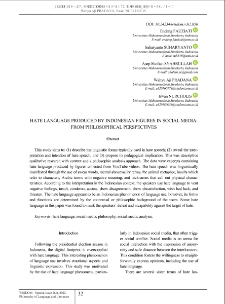Օբյեկտ
Վերնագիր: Hate Language Produced by Indonesian Figures in Social Media: From Philosophical Perspectives
Creator:
Fauziati, Endang ; Suharyanto, Suharyanto ; Syahrullah, Asep Shofian ; Pradana, Wahyu Aji ; Nurcholis, Irwan
Type:
Journal or Publication Title:
Date of publication:
Volume:
Number:
ISSN:
Corporate Creators:
Խ․ Աբովյանի անվան հայկական պետական մանկավարժական համալսարան
Coverage:
Abstract:
This study aims to: (1) describe the linguistic forms typically used in hate speech; (2) reveal the inter-pretation and intention of hate speech,and (3) propose its pedagogical implication. This was descriptive qualitative research with contentand a philosophicanalysis approach. The data were excerpts containing hate language produced by figurescollected from YouTube videos. The hate speech was linguistically manifested through the use of swear words, mental abnormality terms, the animal metaphor, insults which refer to characters,Arabicterms withnegative meaning, and nicknames that call out physical charac-teristics. According to the interpretation in the Indonesian context, the speakers use hate language to vent negative feelings, insult, condemn, accuse, show disagreement, show dissatisfaction, wish bad luck, and threaten.Thehate language appears to be an Indonesianphenomenon of language use, however, its forms and functionsare determined by the contextual or philosophic background of the users.Some hate language in this paper was found to mask the speakers‟defeat and incapability against the target of hate.
Place of publishing:
Երևան
Publisher:
Format:
Identifier:
oai:arar.sci.am:372080
Language:
Օբյեկտի հավաքածուներ:
Վերջին անգամ ձևափոխված:
Oct 8, 2025
Մեր գրադարանում է սկսած:
Apr 1, 2024
Օբյեկտի բովանդակության հարվածների քանակ:
112
Օբյեկտի բոլոր հասանելի տարբերակները:
https://arar.sci.am/publication/401947
Ցույց տուր նկարագրությունը RDF ձևաչափով:
Ցույց տուր նկարագրությունը OAI-PMH ձևաչափով։
-
Իմաստություն=Wisdom=Мудрость
-
Իմաստություն, 2013, N 1
-
Իմաստություն, 2014, N 1 (2)
-
Իմաստություն, 2014, N 2 (3)
-
Իմաստություն, 2015, N 1 (4)
-
Wisdom, 2015, N 2 (5)
-
Wisdom, 2016, N 1 (6)
-
Wisdom, 2016, N 2 (7)
-
Wisdom, 2017, N 1 (8)
-
Wisdom, 2017, N 2 (9)
-
Wisdom, 2018, N 1 (10)
-
Wisdom, 2018, N 2 (11)
-
Wisdom, 2019, N 1 (12)
-
Wisdom, 2019, N 2 (13)
-
Wisdom, 2020, N 1 (14)
-
Wisdom, 2020, N 2 (15)
-
Wisdom, 2020, N 3 (16)
-
Wisdom, 2021, N 1 (17)
-
Wisdom, 2021, N 1 (1) Special issue
-
Wisdom, 2021, N 2 (18)
-
Wisdom, 2021, N 3 (19)
-
Wisdom, 2021, N 4 (20)
-
Wisdom, 2022, N 1 (21)
-
Wisdom, 2022, N 1 (2) Special issue
-
Wisdom, 2022, N 2 (22)
-
Wisdom, 2022, N 2 (3) Special issue
- Editorial board
- Contents
- Editor`s Foreword
- New Nakhichevan Dialect as an Element of the Armenian National Identity
- Philosophy of Dramatisation in the Context of Art Interaction in W. S. Maugham’s Novels
- Modern Ukrainian Grand Narrative: Prospects for Evolution
- Hate Language Produced by Indonesian Figures in Social Media: From Philosophical Perspectives
- Existential-Ontological Manifestations of Time in Khrimian Hayrik’s Essay “Time and Its Essence”
- Philosophical and Discursive Approaches to the Categorisation of Modal Meanings in Multimodal Texts
- The Novels by T. Hardy “Tess of the D’urbervilles” and “Loose” by Panas Myrnyi: Peculiarities of Stylistic Narration
- Problems of Studying the Verbal Semantics of Differential Languages in the Conditions of Bilingualism
- Philosophical Conception of Stable Verse Forms (Based on Yeghishe Charents’s Poetry Analysis)
- Synergetic Concepts “Chaos” and “Order” in Modern English Verbo-Creating Processes
- Paradigm of the Competence of Linguists in the Education System in the Context of Understanding the Philosophy of Language
- Nikolay Gogol and Raphael Patkanyan: The Philosophy of Horror
- Speech Aggression in Corporate Communication: The Gender Aspect in the Philosophy of Culture
- Camus’ Understanding of the Paradoxically Multidimensional Human Being
- US Presidents’ Political Speeches as a Means of Manipulation in 21st Century Society
- Provocation as a Tool of Language Influence
- Promise: Semantic, Communicative and Temporal Aspects
- Various Language-Philosophy Approaches to the Categorization of the Professional Oil Language in English and Russian
- The Role of Personality Type and Self-Determination of Students Majoring in Non-Philological Specialities While Building English for Professional Purposes Competence
- English Biblicisms in Colloquial Speech and a Literary Text: Looking for the Right Interpretation
- Philosophical and Ethical Problems of the Category “Life” in Michael Kozoris’s Novella “Chornohora Speaks”
- The Folk Medicine Concept in Vernacular English of the XIX Century
- Language-Philosophy Anomalies in the Framework of Free Indirect Speech: By the Example of Marina Tsvetaeva’s Prose
- Exploring the Origin of the Present-Day Human Self on the Fringes of Linguistic Advancement
- Perception of José Ortega y Gasset’s Works in Essays of Oksana Zabuzhko
- English Occult Discourse as a Cultural Phenomenon
-
Wisdom, 2022, N 3 (23)
-
Wisdom, 2022, N 3 (4) Special issue
-
Wisdom, 2022, N 4 (24)
-
Wisdom, 2023, N 1 (25)
-
Wisdom, 2023, N 2 (26)
-
Wisdom, 2023, N 3 (27)
-
Wisdom, 2023, N 4 (28)
-
Wisdom, 2024, N 1 (29)
-
Wisdom, 2024, N 2 (30)
-
Իմաստություն, 2013, N 1
| Հրատարակության անուն | Ամսաթիվ |
|---|---|
| Fauziati, Endang, Hate Language Produced by Indonesian Figures in Social Media: From Philosophical Perspectives | Oct 8, 2025 |





